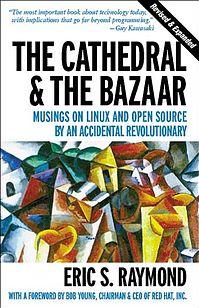The Cathedral and the Bazaar: Musings on Linux and Open Source by an Accidental Revolutionary is an essay, and later a book, by Eric S. Raymond on software engineering methods, based on his observations of the Linux kernel development process and his experiences managing an open source project, fetchmail - wikipedia ![]()

The Cathedral and the Bazaar. Book by Eric S. Raymond
- wikimedia.org ![]()
It examines the struggle between top-down and bottom-up design. The essay was first presented by the author at the Linux Kongress on May 27, 1997 in Würzburg (Germany) and was published as part of the book in 1999.
Raymond points to 19 "lessons" learned from various software development efforts, each describing attributes associated with good practice in open source software development
- wikipedia ![]()
Raymond points to 19 "lessons" learned from various software development efforts, each describing attributes associated with good practice in open source software development
- wikipedia ![]()
Further Thoughts
One can distill his lessons to four key insights about the elements needed to create unstructured value networks: - Connections - Alignment - Belonging - Ego-less center
**Connections** We must be connected to each other in a network.
**Alignment** The creators in the network must be aligned to a common purpose.
**Belonging** Contributions to the network must be validated by others, creating a sense of belonging and a desire for others to contribute for that validation.
**Ego-less Center** There must be a sense of a common good that everyone is working toward that is beyond any individual within the network.
_It might be interesting to look at this model within the context of Koestler's concept of holons. Each node could be considered a holon, making these networks, as complex adaptive systems, holonic, guiding us to the potential of unleashing Holonic Thinking.
# Sections
# See also